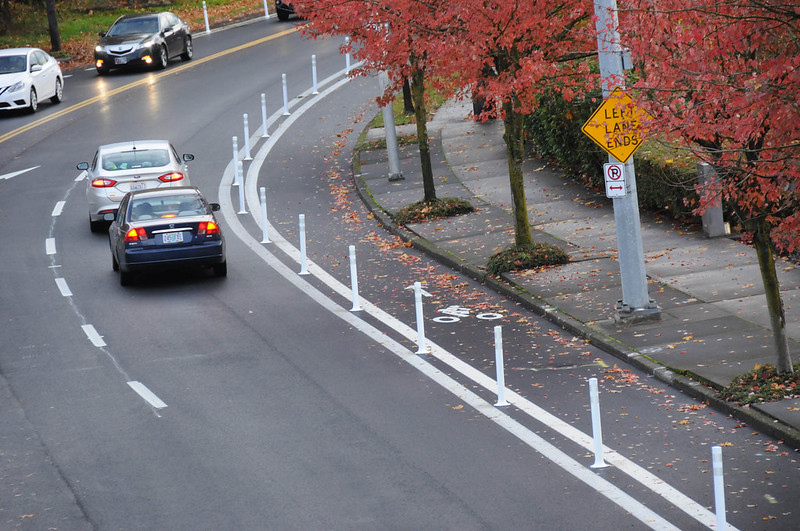
(Photos: J. Maus/BikePortland)
The Portland Bureau of Transportation is on a bit of a plastic wand binge.
In the past week we’ve learned of white wands (a.k.a. delineators, plastic bollards, candlesticks) going up in the Lloyd District, near the Convention Center, and on Greeley near the Adidas campus in north Portland.
My first thought was that this was finally a moment I’ve been looking forward to for a long time: When PBOT systematically goes through their dozens of miles of buffered bike lanes and adds protection to them. Unfortunately PBOT says that time hasn’t come yet; but it’s still good to see them adding physical separators in specific locations.
PBOT Public Information Officer Dylan Rivera confirmed yesterday that they haven’t developed a standard design application for protecting bike lanes, “but have been able to install some on a case-by-case basis.”
I took a closer look at all three of these locations yesterday. Here are my thoughts, along with comments from Rivera.
NE 1st Avenue near the Convention Center
This is a stealth little connection between the Steel Bridge and the Lloyd District. NE 1st in the shadow of I-5 and the Oregon Convention Center gets people from the bike signal at NE Oregon and Interstate to the bikeway on NE Multnomah.
Here’s the PBOT rationale via Rivera: “We installed the wands on 1st Ave because a lot of people driving were using the bike lane as a de facto right turn lane there.”
This is a straightforward application of wands and it vastly improves the short stretch of bikeway they’re used on. Unfortunately there’s still a pesky one-block gap to Multnomah where bicycle users are thrown into a shared lane (with a sharrow). With these new wands, we’re now tantalizingly close to a continous, low-stress connection between the Esplanade and the protected bikeway on NE Multnomah.
NE Multnomah at 9th
Some of you might have noticed these new wands in one intersection on NE Multnoman outside of Lloyd Center Mall. They’ve been added to help people navigate through the mixing zones — areas at intersections where auto users merge into the bikeway to turn right.
The mere fact that we’ve added wands here shows the limits of paint-only bikeway design. Without the wands PBOT relies on yield carats, sharrows and turn arrows in hopes that the straight-going biker and right-turning driver interactions go smoothly.
Rivera said this specific application was done in cooperation with a National Institute for Transportation and Communities (NITC, based at Portland State University) study being led by Chris Monsere. “That study is looking at intersection treatments for protected bicycle lanes and Chris wanted to study the behaviors associated with a protected entry into a mixing zone,” Rivera shared. “In-house we consider that a good design and were more than happy to assist in this way.”
Advertisement
Greeley south of Willamette near Adidas
PBOT took advantage of a paving project on Greeley between Going and Killingsworth to add a buffer to existing bike lanes. Between Going and Emerson (right in front of the Adidas headquarters campus) they’ve now added plastic wands inside the buffered area.
Earlier this week we heard from longtime reader and highly experienced bicycle rider John Beaston (and winner of the 2017 Volunteer of the Year award from The Street Trust) about his concerns with this application. He cc’d us on an email to PBOT’s “Safe” email hotline (safe@portlandoregon.gov) that tracks and responds to livability concerns. “While we appreciate the effort to improve things,” Beaston wrote, “the new bike lane treatment on N Greeley has made things worse for transit users, people on bikes and drivers.”
“We hope this design gets another look and corrected, since it is not been engineered using principles of Vision Zero.”
— John Beaston, local resident
Beaston lives a block away and said he bikes and uses the bus on Greeley to get downtown. His main concern is that PBOT placed wands right in front of a bus stop. “Bus drivers must now stop in the travel lane due to the bollards,” he shared. “Transit users must now carefully cross a wide, fairly high-speed (slight downhill) bike lane. This has created a high-conflict situation where one did not exist previously. In addition, when a bus is stopped in the travel lane, cars now cross the double-yellow line to pass. The double-yellow area also has a northbound left-turn lane just south of the transit stop. There will definitely be conflict between left-turning vehicles and those passing a stopped bus.”
The wands in front of the bus stop are now gone. We aren’t sure if PBOT removed them or if they were victims of bus and car operators.
In his opinion, the “plastic bollards” are ineffective — especially because they continue to be dislodged and scattered all over the bike lane.
“We hope this design gets another look and corrected,” Beaston wrote in his email to the City, “since it is not been engineered using principles of Vision Zero.”
Rivera said the addition of plastic wands in this location, “Is consistent with Director [Leah] Treat’s directive that we ‘make protected bicycle lanes the preferred design on roadways where separation is called for….[on both] existing roadways as well as …[on] new construction.'” We asked Rivera to respond specifically to Beaston’s concerns but haven’t heard back yet.
One of our big concerns with these newly protected bike lanes is maintenance. There were piles of leaves (not to mention a dead wand or two) in the Greeley bike lanes. PBOT has at least one small bike lane sweeper; but we have yet to hear about a strategic plan to keep these new bikeways clean. The agency’s newly released Winter Weather Plans made no mention of cleaning protected bikeways.
And I’m not sure what’s better: Unprotected and clean bikeways, or protected and dirty ones. I wish we didn’t have to choose.
It’s great to see PBOT prioritize protection on bikeways, but the installation of these wands still needs a bit of work. Quality of bikeways matters just as much as quantity. We’ve got to this right if we want people to use these bikeways — and if we want people who don’t use them to respect them.
— Jonathan Maus: (503) 706-8804, @jonathan_maus on Twitter and jonathan@bikeportland.org
Never miss a story. Sign-up for the daily BP Headlines email.
BikePortland needs your support.


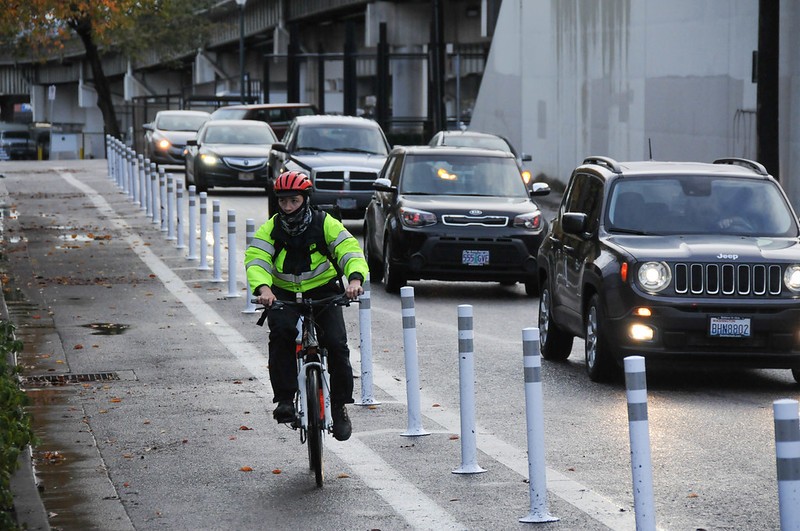
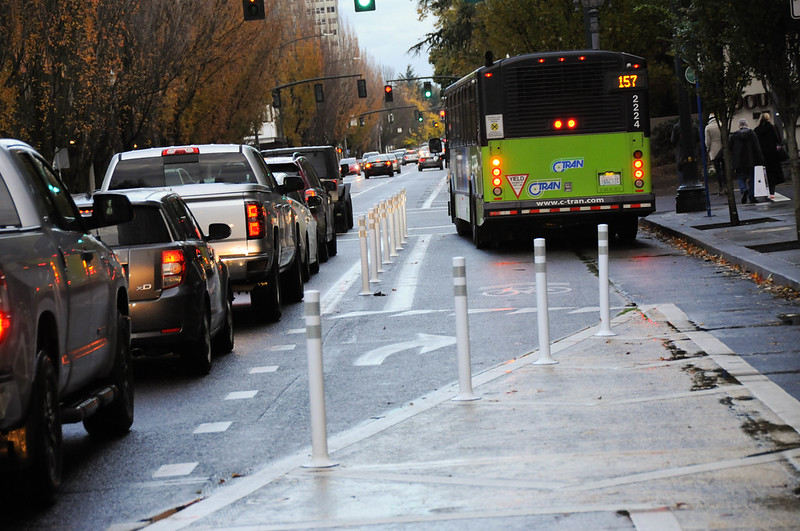

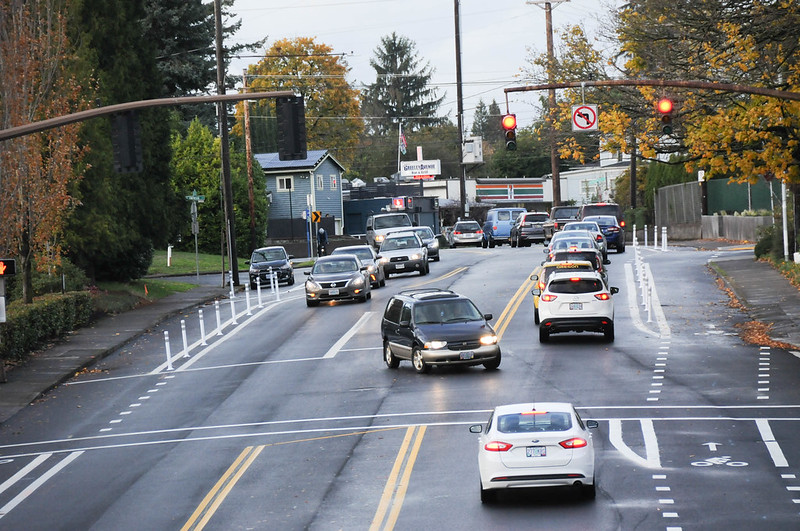
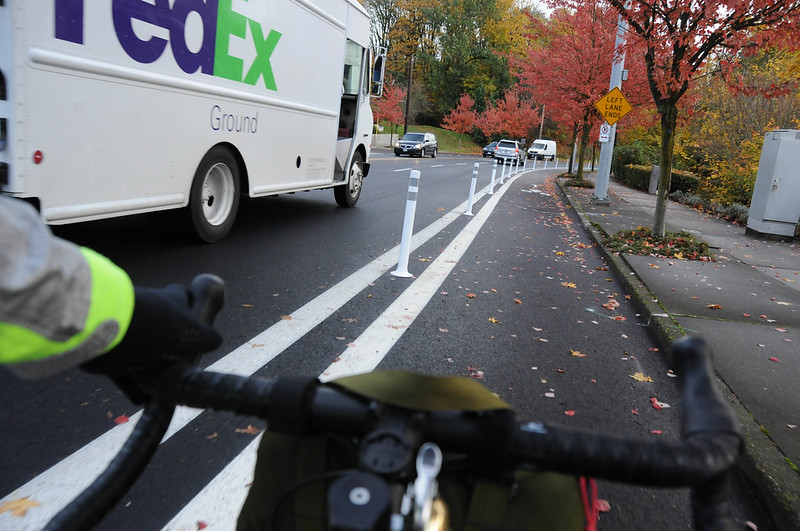

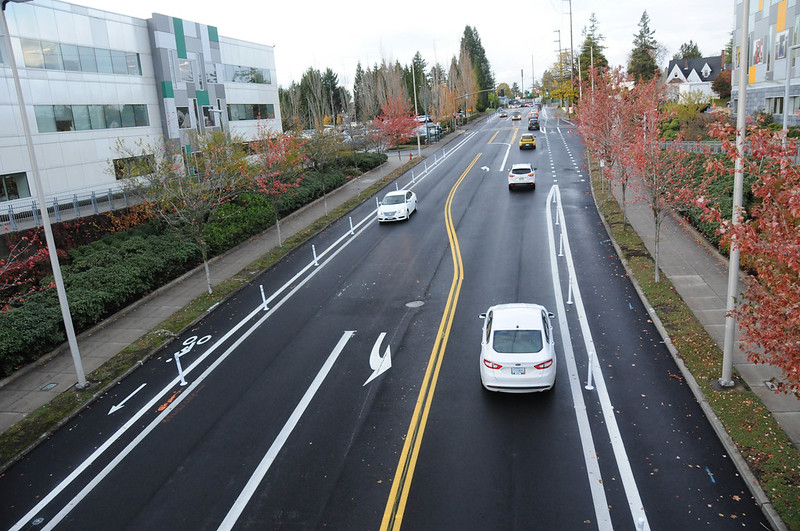
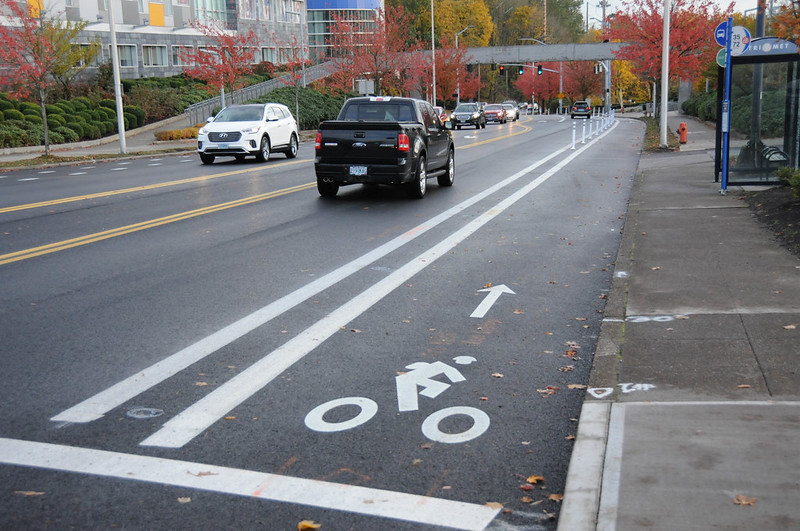
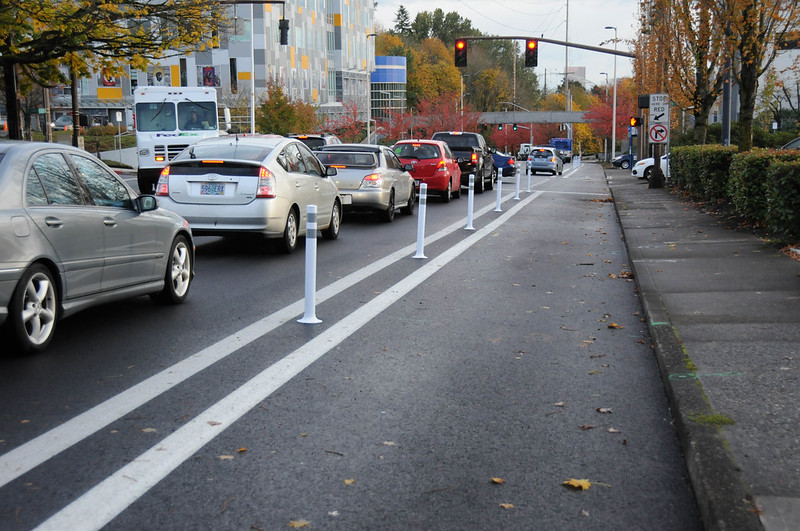

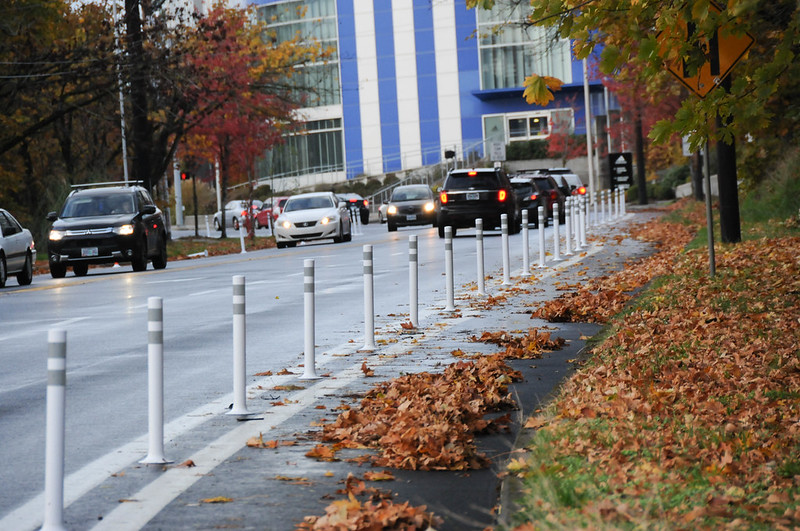

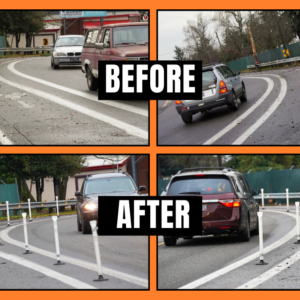


Thanks for reading.
BikePortland has served this community with independent community journalism since 2005. We rely on subscriptions from readers like you to survive. Your financial support is vital in keeping this valuable resource alive and well.
Please subscribe today to strengthen and expand our work.
Automobiles are kind of like goats. Lots of people like them, but if not properly fenced they wreck stuff and ram innocent bystanders.
I expect these bollards will be as about as effective with cars as with goats.
Not that I think bollards or barriers are necessarily a good thing
Automobiles are nothing like goats. They are inanimate objects that can’t do what you describe except while in the control of a human being.
almost every bike lane has leafs blown from the sidewalk into bike lanes this time of year.. * or clear the gutter and make sure they end up in middle of bike lane * :/
I would like to know who is responsible, how and when these bike lanes are going to be cleaned of leaves and other debris.
Exactly! There are already problems at multiple locations including the north end of the east side bike lane on the SE 20th overcrossing of I-84 and other locations the wands are installed.
Who is responsible: private property owners and/or their hired yard crews/
When they will be cleaned up: never.
I was glad to see the wands installed but dismayed by the lack of coordination that meant they didn’t even clean the bike lane before installing them, leaving all the leaves trapped in the bike lane (significantly narrowing its width).
Also, on the NB direction, the turn L onto Willamette Blvd is much better with a wider center area (which seems like it will be also maybe protected – I don’t know, but I hope it is). However, the last set of 5-6 wands right leading up to the turn create a more difficult left because they either force you into the main lane, or significantly shorten the amount of space left to merge before turning left. I would almost rather see these last few wands removed.
Wonder if these will be going on the hill of N. Interstate anytime soon? Not sure if there is much space for them as that bike lane is pretty narrow with no buffer.
I really hope not.
Cycling speeds vary dramatically on that hill, so mucking up passing (only way to do it cleanly is to go in the lane) would be very unwelcome.
I agree Kyle! I also take the lane downhill when the bike lane is full of leaves, and the wands would make that pretty difficult.
reason I use the term ” goat rope ” huge line of traffic.. haha \m/
After reading this, I made a bet with myself that John Beaston (a former BTA board member) is a highly-experienced cyclist that likely has little personal need for protected infrastructure. Google rapidly revealed their bike team memberships, multiple long-distance highway ride blog posts, OBRA records, and published comments about being a bike commuter for 25+ years.
Hmmmm…
PS: My support for bollards here in no way condones the “on the cheap” way in which bollards are installed in Portland.
i hear you soren. And I agree. I will add something to the story that refers to his general experience level.
Apparently anyone who actually has cycling experience is disqualified from commenting?
no. Not at all. The point is that perspective matters. When I can I think it’s valuable for people to know where a person is coming from. In this case, it’s absolutely valid that people know that John Beaston (someone who I know and respect personally by the way) is an experienced rider — especially because this issue is specifically about protected bikeways.
His comments about the bollards are completely valid, so what is your point?
The point is that everyone is applauding PBOT doing things for the lowest common denominator and disregarding more experienced cyclists who either have no need for these measures and/or are experienced enough to know that the designs are significantly flawed but they will now be forced to use them by law.
The state needs to either repeal the ORS mandatory side path requirement, or design infrastructure that accommodates all skill levels of cyclists, and not just beginners. Even beginners become more experienced over time and may no longer have a need for some of these facilities.
Yes, good point. Repeal the mandatory side path law.
Sometimes feels like city is just trying to create linear parks for all sorts of uses, as opposed to making high quality, efficient cycle commuting lanes.
When somebody parks their maintenance or delivery truck in the protected bike lane, inside the wands, we will have a much more dangerous situation of trying to cycle out in the car travel lane; the wands work both ways – to cement cars’ expectation and attitude that a biker should never be in the main travel lane – regardless of what hazards are in the bike lane.
We definitely need these wands in some locations, but this whole treatment on Greeley seems like a weird place for it.
Wider painted lanes are really great here on Greeley, but the city missed the biggest pinch point and most dangerous spot on this entire stretch – the uphill side of the Going bridge, where the bridge guard rail sticks out into the bike lane and both downhill bikes and cars have to jog left at speed just as the left turn lane is filling with stopped vehicles. This point was the most dangerous on the entire section, and city did nothing to it and did not widen it. I don’t get how they can fail to change the most dangerous section of the road, but mess around with a bunch of other areas in a half-way means. Road is as dangerous as its most sketchy section – that’s the low hanging fruit.
To the best of my knowledge, the mandatory sidepath law has not been enforced in Portland since the PPB lost two traffic court cases:
https://bikeportland.org/2006/11/07/expert-witness-backfires-on-da-in-bike-lane-case-2497
Doesn’t matter. If you do get a citation, good luck fighting it, at a minimum it will cost you money and time; if you get hit and injured or killed outside the mandatory facility, good luck getting a favorable settlement.
imo, people riding for decades on roads without infrastructure represent a demographic that has the least need for bikeway protection. a quote from someone who appreciates protected infrastructure would have provided some balance.
Agreed that such riders have the least need for protection and that perspectives from others are relevant.
However, there is a reason why support for certain types of infrastructure, gооfball products such as Backup Barz and solid core tires, and unsafe practices such as riding against traffic is found almost exclusively among nonriders (or people who ride very little)
We all start out with no skill/knowledge, and it’s not like experience makes you forget everything obvious and unable to figure things out. Ideas that sound great in the abstract sometimes work out very differently in practical environments.
I haven’t ridden these specific areas since the bollards were installed so I don’t have an opinion one way or another, but I tend to view them as a negative thing rather than a positive thing. Buffered lanes, however, are quite nice along fast busy streets.
The need for facilities for multiple skill levels of cyclists should not be tainted by the ‘vehicular cyclist’ cult; they were actually correct about a lot of things but the dogma and the abrasive personality of Mr. Forester unfortunately hurt their message; but that doesn’t mean that they didn’t make some good points, like that through bikes should not be to the right of right-turning motor vehicle traffic.
I totally agree that facilities need to be set up for a range of abilities, but speaking only about Greeley since that is closest to me, the choice of where and how things are done is just weird as this is one of the slower and easier sections of that road. Disclaimer: I haven’t ridden any of these sections since the wands came up so my comments are based entirely on what I’ve seen on BP.
There is absolutely no comparison between this area and the I-5 merge down the hill or what practically the rest of Greeley is like all the way up to Lombard. It feels almost like one of the criteria for figuring out where to install them was where have the lowest chance of getting clipped or hooked and traffic moves the slowest.
Agreed. Given the proportions of these people in Portland’s only logical path to 25% bike mode share, I’d advise many more “interested but concerned” voices than “decades of experience” voices.
Having had a reasonable claim to “Interested But Concerned” mindset/behavior until a year ago, I suspect that many “Interested But Concerned” folks would say, “This feels a lot better to me than the old, just paint, way – especially in the spring and summer. If the City would just get the darn leaves (and gravel, in the winter) out of the lane regularly, I’d be reasonably satisfied. A barrier that might actually deflect a car, and that wouldn’t get so easily torn out by motor vehicle users and left in my way would be even better.”
I see the logic, but if that were true, why are some areas that are filled with cyclists in the summer virtually empty in winter?
Separated infrastructure can help in certain situations, but it’s only possible in particular areas. There are certain things you simply can’t avoid — such as riding with traffic at least some of the time, distance, hills, and weather.
The 25% bike mode share goal is just a marketing number and a silly one at that. Even if we had the most perfect cycling infrastructure in the world, why would anyone think it’s even remotely possible? The Netherlands is constantly held up as a beacon, but it’s a lot easier for people to cycle when people are going much shorter distances on totally flat land.
BTW, their national speed limit is over 80mph — we’re talking a country that’s only 60 miles wide and 160 miles long.
There’s a huge difference between riding with traffic on a heavily diverted, low-speed, low-traffic street (the main “riding with traffic” experience in, say, Groningen or Copenhagen) and riding with traffic on Greeley.
I don’t think either of us has done the analysis to know whether 25% is truly reasonable. I’m quite hopeful about achieving 25% of all TRIPS; less so about 25% of all COMMUTE trips. It certainly requires some huge changes, like comfortable infrastructure for anyone to bike, pricing auto parking in a much larger part of the city, ubiquitous residential bike parking, etc. Many of these aren’t in any City plans.
I’m quite certain that the percentage of trips can be noticeably and that infrastructure is related to this. I am still less certain of the 25% figure.
Even given excellent infrastructure, active transportation for the masses basically requires short distances and reasonable comfort. Portland is better than many cities about having services scattered throughout which helps with the distance thing for many people. However, distances and hills are a big deal for most people. Weather is also a major factor. Take today. There are some areas that are teeming with peds in good weather. Hardly any today. We get quite a bit of cool rain out here.
Since people need to get around in bad weather as well as good, this unfortunately means that infrastructure needs to be geared towards that.
NE 1st is also a “stealth connection” from downtown to N Portland, via the Steel Bridge, NE 1st, Multnomah, NE 3rd, then Rodney from Hancock to Killingsworth.
Good to see PBOT doing more for bikes,
Ted Buehler
I’ve never actually seen the bike lane sweeper in action. Has anyone?
“Rodents Of Unusual Size? I don’t believe they exist.”
In all seriousness, I have never seen any evidence that they have or use a bike lane sweeper. When I saw the article this morning, I called PBOT and left a message asking them to get back to me with details of their plan to keep protected lanes free of debris. I recommend others call them as well; let’s put some pressure on them to do it better.
LOL!
Part-way to vision zero solution: Make every the first post and then every third or fifth post metal and anchored into pavement.
Smashed bollards and wands make empirical evidence for real infrastructure.
Glad to see more protected lanes going in, but you can say goodbye to at least a few of the ones shown on Greeley within a week. Plastic bollards on curved roads simply do not work. Period. Other treatments are needed: either raised curbs or tougher separators.
Why not put down the concrete curbs that Seattle uses all over the place to separate opposing car traffic from each other, and even left-turning traffic from non-turning traffic. These would seem to be ideal for keeping cars out of protected lanes, possibly topped with plastic bollards for visibility:
https://www.google.com/maps/@47.6904116,-122.3445784,3a,75y,171.12h,63.97t/data=!3m6!1e1!3m4!1szDzFYnX_G4u85l6PpBuigA!2e0!7i13312!8i6656
No way concrete curbs on curves could possibly represent a threat to cyclists. No siree, Bob.
More than planters? As with bollards, there would be gaps in the curbs. Honestly, you can’t idiot-proof all our infrastructure. Better to physically protect bikes from cars than to protect bikers from themselves.
There are areas where vehicles clipping curves is an issue. This is not one of them. I would go so far as to say it is less of a problem here than most places.
Anyone who worries about that in this particular section of Greeley won’t be able to ride the rest of the road which provides substantially greater threats and is considerably more challenging.
Barriers here have more potential for harm than good, especially for cyclists.
I see barriers as having a great potential to inflict harm upon cyclists. The bioswales along SW Moody could present such a threat to a new rider and a rider swerving to avoid a sudden object in the pathway (e.g. another person falling over). The result would be a faceplant into the bioswale structure which doubles as a barrier to auto traffic. We should be designing infrastructure to minimize potential harm would safeguarding against conflict as well. In the case of the bioswale, why not cap it? water could still run into it but cyclists’ risk of crashing into (perhaps literally) would be unlikely.
Since everyone is complaining about debris, the inevitable outcome of placing barriers will be to trap debris in the bike lane. Cyclists won’t have the option of leaving the lane even partially to avoid it which will be totally awesome when riding in the dark and wet.
Chris Monsere’s a good egg. there’s a pretty good group of forward-looking folks teaching transportation engineering (and planning, though I’m less familiar with that) at PSU. sadly, many PSU engineering students end up with internships at ODOT and come to the conclusion that what they learned will never be implemented.
I don’t want eggs designing my bike facilities, I want a competent cyclist that understands the needs of all skill levels of cyclists.
for what it’s worth, the Civil and Environmental Engineering department wins all the PSU bike challenges by safe margins. many of this region’s future transportation engineers are cyclists. as is Chris Monsere.
If PBoT wants to put these wands in, they should first change the crowning and drainage so that the bike lanes don’t end up completely useless traps for debris.
However, if the purpose is to shove people on bikes into completely useless spaces in the hopes of simultaneously silencing the loudest voices for “protection” while also killing off cycling in Portland, this is definitely an approach that shows promise.
Thanks for the depth treatment on protected lane maintenance in this story – wish you could pin down Rivera on it a little better…. I suspect they have no special plan for bike lane sweeping on arterials (and now with wands), which is really unfortunate.
When I emailed ODOT about the debris on the shoulders of outer-Sandy Blvd, they replied and said that the shoulders were “self-cleaning”.
Hilarious!
WTF?!?!?!?!?!?!?
Sometimes I do throw the debris back into the center roadway. So yes, ODOT is correct in identifying this behavior as “self-cleaning”, but I don’t think they had this particular action in mind here..
You purposely throw debris in the path of vehicular traffic? Might I ask why? Absolutely nothing good can come of it.
This sort of action needlessly presents a threat to all road users — including cyclists unlucky enough to be in the vicinity of debris hit by a vehicle.
Thanks for asking. There are multiple factors behind the action. First is that heavy vehicles obliterate anything and everything eventually in their path given time. Bicycles will never achieve the same efficiency in eliminating objects in the path. Further, by removing debris from the bike path, where it would otherwise remain indefinitely, the chance of the same debris being destroyed and/or removed where the street sweepers is much more likely. Due to the literally marginalized nature of bike lanes and shoulder space, they are often not reached by street sweepers.
By leaving debris in the bike lanes, the potential harm to individuals is much higher and more likely. If we are able to bring debris to a trash bin that is the best option of course. Short of that, remove the debris from the bike lane and place it in the travel lanes which are serviced with much higher frequency. Unfortunately, Portland does not have sidewalk cleaning services outside of the downtown core. Moving objects (small typically) to the shoulder may result in them resting there forever and not a good general strategy.
It’s true that bikes don’t naturally eliminate debris like vehicles, stuff in the vehicle lane is more likely to be swept up, and that anything thrown on the sidewalk is likely to stay there. But the rest of what you describe doesn’t work in a practical environment.
Even if most debris eventually gets obliterated, some doesn’t and it’s a threat in the meantime. Debris hit by vehicles is unpredictable and dangerous. It sometimes flies fast and can hit you in the face or go into your bike which doesn’t sound like a big deal until something (stick, piece of metal, etc.) goes into your front wheel just wrong causing instant lockup. Smaller debris are hard to see and act like gravel when you hit them.
In addition, roads are crowned — this pushes debris right back to the side which is why roads that are not ever swept are usually quite clean in the travel lanes with debris on the side.
If something is a threat and you decide to do something with it, better to toss it to the right. It doesn’t belong in the path of anyone who may be moving at speed.
I can’t comment about the Mult or NE 1st treatments as those look pretty good, but the wands on Greeley are a bit of a head scratcher…. IMO, the most useful purpose they have are to keep the bus out of the bike lane, but now that’s gone. I guess one more use is to keep folks who pull over in the bike lane to take a phone call and use it as a breakdown lane out of there, also.
Not sure how these wands really add actual safety in this location or why it was chosen over many more places in much greater need of this treatment, although the much wider double striped lanes after re-painting are better than the older lanes. Of course the wands claw back the width of the bike lane back to the first painted stripe, anyway. How come wands are not located on outer stripe?
Because the buffer is not meant for riding in, but rather to be…a buffer. Hence the name.
Riders can be anywhere in the lane (see the pics for this article), so having more space to work with for passing is nice for everyone. Even the pic that Jonathan appeared to take over his own bars doesn’t allow for a clean pass 😉
A lot of cyclists already have lousy passing habits. Penning them in tight spaces with debris is not going to improve the situation.
The buffer is not bike space or cars space. As Momo stated, it is space not meant for use by either.
Does this mean you think passing cyclists should *not* pull out to give more space to those they’re passing?
Unless slower cyclists ride on the right side, there’s not enough space for a clean pass. The logical outcome of putting wands in that prevent clean passing is really close passing. Not as safe for anyone, and it will be much more unnerving for less experienced riders.
Another step in the right direction for PBOT. It would be very useful to install these all around the Rose Garden (aka Moda Center) to help deal with the persistent issue of uber/lyft drivers parking in the bike lanes on Multnomah & Wheeler.
I am glad that PBoT is moving forward on the use of physical separation go cyclists at points where motorists like to conflict…though I am still strongly concerned about:
1) maintenance;
2) finding a better delineator for separating bikeways and motor vehicles (as the wands rarely function well long term when placed between high friction vehicle lanes of any sort – car on car lanes etc); AND
3) the issue of late season capital project work (wet and cold weather) being used in a high frequency to work on bikeway and led projects…this may be great for the contractors and PBoT staff scheduling but does it degrade on the longevity of the work and safety outcomes.
Am I fantasizing, or are the angry grilles of the five cars lined up behind the lone cyclist on NE 1st about to engage in a feeding frenzy?
Is it too late to chime in and say I hate this for some reason?
oh, because of the leaves. that’s why we all hate this one.
That last bit is the part that concerns me most. I could likely argue my way out of a ticket in court, but I know that law would eliminate any civil settlement in the event of a collision.
That was supposed to be a reply to Buzz’ comment about the liability of the mandatory sidepath law.
From this post by Jonathan:
“One of our big concerns with these newly protected bike lanes is maintenance. There were piles of leaves (not to mention a dead wand or two) in the Greeley bike lanes. PBOT has at least one small bike lane sweeper; but we have yet to hear about a strategic plan to keep these new bikeways clean. The agency’s newly released Winter Weather Plans made no mention of cleaning protected bikeways.
…
And I’m not sure what’s better: Unprotected and clean bikeways, or protected and dirty ones. I wish we didn’t have to choose.”
I have recently contacted PBOT about looking into a human+electric powered solution to cleaning these limited-access bike lanes. I’m simply interested in starting a conversation, but my gut tells me that an eTrike pulling a sweeping trailer has some merit.
To be clear, there will likely still need to be a few of the large machines [some over $200K, all run on diesel], but why not consider a small fleet of trikes+trailers buzzing along the bikeways clearing a path?
I’ll keep you posted on progress, as I may need to come back here for support. Bureaucracy is a thick sludge.
Stay tuned.
Perhaps like the city’s “adopt a drain” message of civic engagement, we could “adopt a block” for greenways, arterials, collectors, and multimodal pathways that are underserviced via the complaint-driven lane sweepings. I know after last year’s snowstorms and having waited over three weeks for PBOT to clear up the residual gravel, I ended up sweeping four blocks of gravel off the roads. It took a few hours, but it made the commute for several cyclists much safer. Ideally, we need a city-wide, systematic response to the debris that can accumulate within these narrow and/or protected paths. Until then I would encourage each of us to identify a block that they could commit to keeping cleared.
So you’re saying the city builds a crappy bike lane no one wants or needs, and then it accumulates all kinds of debris and isn’t kept clean, we should do it ourselves? LOL, good luck with that.
” Until then[…”
I’ve been seeing drivers on Multnomah make right turns onto 9th from the through lane since the bollards went up. Either people are confused about whether or not they can still use the right turn lane or they’re just missing the smaller window to get into it.
PBOT appears to use two types of plastic wand aka bollard. One is plastic all the way to the flared base that is attached to the pavement. The other has a narrow black rubber hinge section in the last inches before the pavement. What’s the difference; is one more resistant to damage from cars?
Here is an example of the former:
https://static.grainger.com/rp/s/is/image/Grainger/3UTX1_AW01?$zmmain$
Here is an example of the latter: http://www.impactrecovery.com/images/products/67/delineator_app1_300x300.jpg
In theory, the hinged one pops back up more often, so would last longer installed.
There is also the variant that looks like it screws into the pavement a la Better Naito. These strike me as a pretty decent design.
I strongly prefer wands that are designed to yield under very little pressure because they allow cyclists to safely get very close to them. I smacked the wands on BN several times when passing people while trying to cut more space. Those ones work nicely — just stung my fingers a bit as they went down and popped right back up.
Wands that don’t yield sufficiently are a threat to cyclists who have to maintain more space from them. This means that slower cyclists will get less clearance when passed by faster cyclists.
i did see what appeared to be convention center crew blowing the leaves out of the bike lane on NE 1st, but i wonder what will happen now during the cars shows at the convention center. they usually use the NE 1st St. bike lane as a staging area for the cars. now with the posts there, i wonder if they still will do that.
Last time one car lane was fenced off and made a bike lane, with the bike lane serving as the staging ground. They could do that again – especially if cars fit without having to remove and after replace the bollards – or put the parked cars in the right car lane.
The initial installation of wands in front of the bus stop was most likely a simple mistake, quickly fixed, rather than intentional. It goes against ADA rules and city policy to have buses stopping in the street rather than against the curb, since a wheelchair user wouldn’t be able to board in that case. Many bus stops unfortunately still have on-street parking allowed in front of them, but those are typically fixed whenever any transportation project touches the street.
Overall, I don’t think it’s too big of a deal to have buses stopping in the bike lane as long as it’s not a layover spot or time-point spot (where buses wait to get back on schedule), not a heavy ramp deployment spot, and not a super-crowded bike corridor. Greeley only attracts cyclists willing to climb a steep hill, so it doesn’t have nearly the use of Williams, for example. On Williams it was pretty much essential to remove the bus-bike interaction, but on Greeley it seems less important. There’s no room for bus islands anyway.
Fixed it for you:
And overall I don’t think it is a big deal to have buses stopping in the general traffic lane as long as it’s not a layover spot or time-point spot (where buses wait to get back on schedule), not a heavy ramp deployment spot, and not a super-crowded bike corridor.
If they are stopped in the lane, I would not pass on the right anyway (like the hawthorn ramp and others), out of respect to the people getting off the bus.
Do you want to?
Passing a stopped bus on the right is dangerous and stuрid.
Practically by definition, a stopping bus is dropping off and/or picking up passengers. Those boarding the bus have right of way and their attention will be on that task (or in their phones). People passing from behind cannot see when people are stepping off or the speed that they’re moving.
A bus that’s pulled into the lane leaves a gap big enough to pass on the left. Note that you’re required to yield to a bus that’s pulling out and if it was stopped at a crosswalk, you need to be on the lookout for peds.
When I saw all these bollards go in on Greeley, I was almost heartbroken. Significant effort and money spent with good intentions that will end up being completely wasted. I was wondering if it was something Adidas had asked for? Like how New Seasons got that short stretch of bike lane added on Lombard.
One other thing. Didn’t anyone remember that Portland gets snow and ice in the winters from now on? I’d say the bollards would screw up snow removal, but I don’t expect they’ll last all that long.